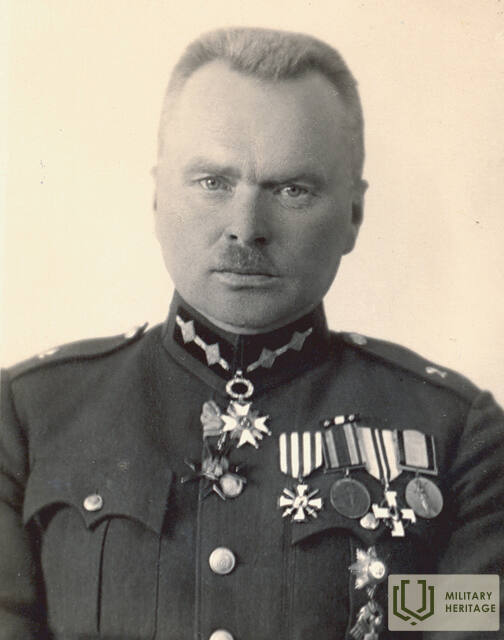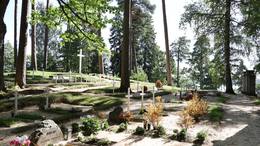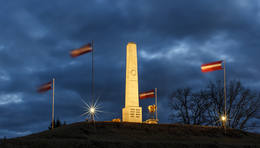A moment of remembrance at the Garrison Cemetery
After the restoration of Latvia's independence, Uldis Veldre, head of the Alūksne Brothers' Cemetery Committee, took on the responsibility for maintaining the Garrison Cemetery, identifying the resting places of the LKOK related to Alūksne, and installing memorial signs in the Garrison Cemetery.
“When I learned that V. Spandegs (1890-1941) had died, I organized a celebration of his 100th birthday on December 19, 1990, under the conditions of the Soviet occupation, at the Alūksne Garrison Cemetery near the large white cross, unveiling the white marble plaque of Lāčplēsis there. There are always fresh flowers next to this memorial plaque, it is carefully cleaned, we especially mark the dates of birth and death of General V. Spandegs - December 19, October 16 and Lāčplēsis Day - November 11. It was also on October 16, when we commemorated the 60th anniversary of the death of Lāčplēsis Vilis Spandegs. The guard of honor with the Latvian flag and the battalion flag was the brave defenders of the fatherland - soldiers of the Alūksne Mobile Rifle Battalion (MBS), E. Glik Alūksne State Gymnasium flag bearers. In 1938, the flag - a gift from the 7th Sigulda Infantry Regiment to the Alūksne State Gymnasium - was presented by Colonel Vilis Spandegs. At the end of the lesson of love for the Fatherland, the family of our national hero - Lāčplēsis Vilis Spandegs, the Alūksne Brothers' Cemetery Committee, the Alūksne MSB, Lāčplēsis Eduards
Kokle's grandson Sandris, great-grandson Alberts and great-granddaughter Adele Līviņi planted an oak tree so that the bright memory of the last commander of the 7th Sigulda Infantry Regiment, the Cavalier of the Order of the Tomb of Lāčplēsis, the then Colonel Vilis Spandegs, would live forever. We brought the oak tree together with the MSB guys from the land of the great Latvian Zigfrīds Kalačis. The choice was not accidental. In the early spring of 1919, during the battles near Rezaka, Jaunlaicene, Ape, the second battalion of the Valmiera Regiment was commanded by our local (from Gauje) Kārlis Bojārs - Cavalier of the 3rd Class of the Order of the Tomb of Lāčplēsis, commander of the 7th Sigulda Infantry Regiment before the arrival of Colonel V. Spandegs in Alūksne in 1936. Heroes do not die. They will live in the hearts of our people even when my generation - the true bearers of Alūksne and Latvia's history more than 60 years ago - is gone. May there never be a shortage of heroes who are able and willing to give everything they have for their homeland, their country and their people."
Uldis Veldre, head of the Alūksne Brothers' Cemetery Committee. Alūksne commemorates Vili Spandega. Stories about the Lāčplēši. Free Latvia: Joint "London Newspaper" and "Latvija", 2001, November 10, No. 43.
https://www.youtube.com/watch?v=jtzCjhm80so
Related timeline
Related objects
Alūksne Garrison Cemetery
Located on the shores of Lake Alūksne, on the Kapsētas Peninsula, in the territory of the Great Cemetery.
They began to be created and maintained with the care of soldiers of the 7th Sigulda Infantry Regiment in the 1930s and were consecrated on November 11, 1932. After the restoration of Latvia's independence, the care for the maintenance of the Garrison Cemetery, the identification of the resting places of the LKOK related to Alūksne, and the installation of memorial signs in the Garrison Cemetery was undertaken by Uldis Veldre, head of the Alūksne Brothers' Cemetery Committee department.
Military personnel of the Army of the Republic of Latvia are buried in the garrison cemetery, as well as soldiers and civilians who fell in the fight against the Bolsheviks on July 4, 1941 in Alūksne near Jāņkalniņš and on July 7, 1941 in Ziemers parish near the Prinduli houses.
Most of the burials have white wooden crosses with metal plaques that mention the name of the deceased, their rank or occupation, as well as their date of birth and death.
On December 19, 1990, a memorial plaque was unveiled at the Garrison Cemetery to the Cavalier of the Lāčplēsis War Order, Vilis Spandegs. Typical memorial plaques were also installed for LKOK who died or were murdered in communist concentration camps and were not buried in Latvia. On November 11, 1990, a memorial plaque was installed for LKOK Voldemārs Zaķis, who died in a communist concentration camp.
Monument to the soldiers of the 7th Sigulda Infantry Regiment who fell in the Latvian War of Independence
Located on the shore of Lake Alūksne, on the side of Pskevas Street (Kolberg Street).
On June 22, 1923, the President of Latvia, Jānis Čakste, unveiled a monument to the fallen soldiers of the 7th Sigulda Infantry Regiment. The monument was designed by artist Jūlijs Miesnieks.
The soldiers of the regiment also improved and maintained the area around the monument. The soldiers gathered at the monument on the eve of the regiment's anniversary celebration, when they lit the sacred fire, as well as on the day of the regiment's anniversary after the parade and intercession at the Garrison Cemetery.
In 1940/1941, the Bolsheviks removed and destroyed the plaque, but the monument itself was demolished in 1953 and its stones were built into the corner foundations of the barracks building.
As the Awakening began, the area around the destroyed monument, which was still located in the territory of the USSR occupation troops at the time, was cleaned up in the autumn of 1989. On November 11, a temporary granite memorial was unveiled at the former location of the monument, with the text engraved: "The monument to the 7th Sigulda Infantry Regiment will be restored at this location on November 11, 1989."
Thanks to the initiative of U. Veldre, head of the Alūksne Brothers' Cemetery Committee, restoration work on the monument was begun and the restored monument was unveiled on October 16, 2009.
Unlike the original monument, a cross was created on the obelisk instead of the regimental breastplate. Both reliefs of the monument were forged by sculptor Ainārs Zelčs. Both parts of the 22 original obelisk blocks, which were found on the territory of the Infantry School of the National Armed Forces, and newly made blocks were used for the restored monument.
On June 20, 2019, as part of the centenary events of the 7th Sigulda Infantry Regiment, a memorial site for the regiment's monument and a granite memorial plaque to the fallen soldiers of the unit were unveiled at the foot of the monument hill, engraved with the text: "Your strong spirit always ranks with us...". The memorial site was built with funds donated by the personnel of the Infantry School of the National Armed Forces.







